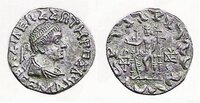King Hermaeus
|
|
HermaiosGB.jpg
HermaiosIG.jpg
Obv: Helmetted bust of Hermaeus " with Greek legend: BASILEOS SOTEROS ERMAIOU "Saviour King Hermaeus.
Rev: Zeus seated on throne, with scepter, and making a benediction gesture with the right hand. Monogram. Kharoshti legend MAHARAJA TRATARASA HERMAYASA "Saviour King Hermaeus".
HermaeusCalliope.jpg
Obv: Conjugate busts of Hermaeus with Kalliope. Greek legend: BASILEOS SOTEROS ERMAIOU KAI KALIOPIS "Saviour king Hermaeus, and Kalliope."
Rev: King panoplied and armed, on a prancing horse. Kharoshthi legend: MAHARAJASA TRATASA HERMAYASA KALIYAPAYA "Saviour king Hermaeus, and Kalliope."
Hermaeus (ca. 90-70 BCE) was one of the last of the Greco-Indian kings, who ruled in the Hindu-Kush territory of the Paropamisadae, with his capital in Alexandria of the Caucasus, near today's Kabul in Afghanistan.
| Contents |
A prosperous reign
Hermaeus has one of the most abundant coinage of the Indo-Greek kings, suggesting a prosperous reign. His rule came to an end when the Yuezhi, coming from neighbouring Bactria overtook his Greek kingdom in the Paropamisadae around 70 BCE. Although the Indo-Scythians displaced the other Indo-Greek kings in the area of Gandhara to the east, no archeological remains or coins have ever been found in the territories formerly ruled by Hermaeus.
Following his reign, it is generally considered that Greek communities remained under the rule of the Yuezhi Hellenized nomads, continuing rich cultural interraction (See Greco-Buddhism).
The coinage of Hermaeus was copied widely (posthumous issues), in a rather barbarized form by the new nomad rulers down to around 40 CE (see Yuezhi article). The Kushan ruler Kujula Kadphises emphatically associated himself to Hermaeus on his coins, suggesting he was either a descendant by alliance of the Greek king, or that at least he wanted to claim his legacy. In any case, the Yuezhi-Kushan preserved a close cultural interraction with the Greeks as late as the 3rd century CE.
Hermaeus and Kalliope
Hermaeus issued joint coins of himself with his queen Kalliope.
The coin type on the reverse departs from the traditional Hermaeus format, in that it shows the king on a prancing horse, rather than Hermeaus' usual seated Zeus figure.
The "king on a pracing horse" is characteristic of the contemporary Greek kings in the eastern Punjab such as Hippostratos, and it has been suggested that the coin represented a marital alliance between the two dynastic lines.
Contacts with China
Hermaeus50BCE.jpg
Obv: Diademed bust of Hermaeus with Greek legend: BASILEOS SOTEROS ERMAIOU "Saviour King Hermaeus, with square omicron letters.
Rev: Zeus seated on throne, with scepter, and distinctly making the vitarka mudra gesture with the right hand. Kharoshti legend MAHARAJA TRATARASA HERMAYASA "Saviour King Hermaeus".
A Chinese historical record from the Hou Hanshu seems to indicate that Hermaeus received the support of the Chinese against Indo-Scythian occupants, and may explain why his kingdom was suddenly so prosperous despite the general decline of the Indo-Greek during the period. The Chinese records would put Hermaeus's dates later, with his reign ending around 40 BCE.
According to the Hou Hanshu, W'ou-Ti-Lao (Spalirises), king of Ki-pin (Kophen, upper Kabul valley), killed some Chinese envoys. After the death of the king, his son (Spaladagames) sent an envoy to China with gifts. The Chinese general Wen-Chung, commander of the border area in western Gansu, accompanied the escort back. W'ou-Ti-Lao's son formented to kill Wen-Chung. When Wen-Chung discovered the plot, he allied himself with Yin-Mo-Fu (Hermaeus), "son of the king of Yung-Kiu" (Yonaka, the Greeks). They attacked Ki-Pin (possibly with the support of the Yuezhi, themselves allies of the Chinese since around 100 BCE according to the Hou Hanshu) and killed W'ou-Ti-Lao's son. Yin-Mo-Fu (Hermaeus) was then installed as king of Ki-Pin, as a vassal of the Chinese Empire, and receiving the Chinese seal and ribbon of investiture.
Later Yin-Mo-Fu (Hermaeus) himself is recorded to have killed Chinese envoys in the reign of Emperor Yuan-ti (48-33 BCE), then sent envoys to apologize to the Chinese court, but he was disregarded. During the reign of Emperor Ching-ti (51-7 BCE) other envoys were sent, but they were rejected as simple traders.
These events may have initiated an alliance between the Greeks and the Yuezhi (even possibly a dynastic alliance), explaining why the Yuezhi gained pre-eminence after the reign of Hermaeus, why their rulers such as Heraios then minted coins in a way very faithfull to the Greek type, and why the first Kushan emperor Kujula Kadphises associated himself with Hermaeus on his coins, in a way characteristic of a ruler asserting his pedigree.
Biblical connection
Although rather unlikely, some Biblical scholars have suggested that Hermaeus may have been one of the three Kings (or Magi) from the east who are related to have visited Jesus at the time of his birth:
"After Jesus was born in Bethlehem in Judea, during the time of King Herod, Magi from the east came to Jerusalem and asked, 'Where is the one who has been born king of the Jews? We saw his star in the east and have come to worship him" Matthew 2:1-8 .
| Preceded by: Niciuas | Indo-Greek Ruler (Paropamisadae) (90-70 BCE). | Succeeded by: Yuezhi rulers |
External links
- Coins of Hermaeus (http://www.wildwinds.com/coins/greece/baktria/kings/hermaios/t.html)
- More coins of Hermaeus (http://www.coinarchives.com/a/results.php?results=100&search=Hermaios&Thumb=1)
- Hermaios and the birth of Jesus (http://www.forumancientcoins.com/inv0.asp?par=809&pos=1)
See also
- Greco-Bactrian Kingdom
- Seleucid Empire
- Greco-Buddhism
- Indo-Scythians
- Indo-Parthian Kingdom
- Kushan Empire
References
- "The Greeks in Bactria and India", W.W. Tarn, Cambridge University Press.
- "The Coin types of the Indo-Greek Kings 256-54 BCE", A.K. Narain


